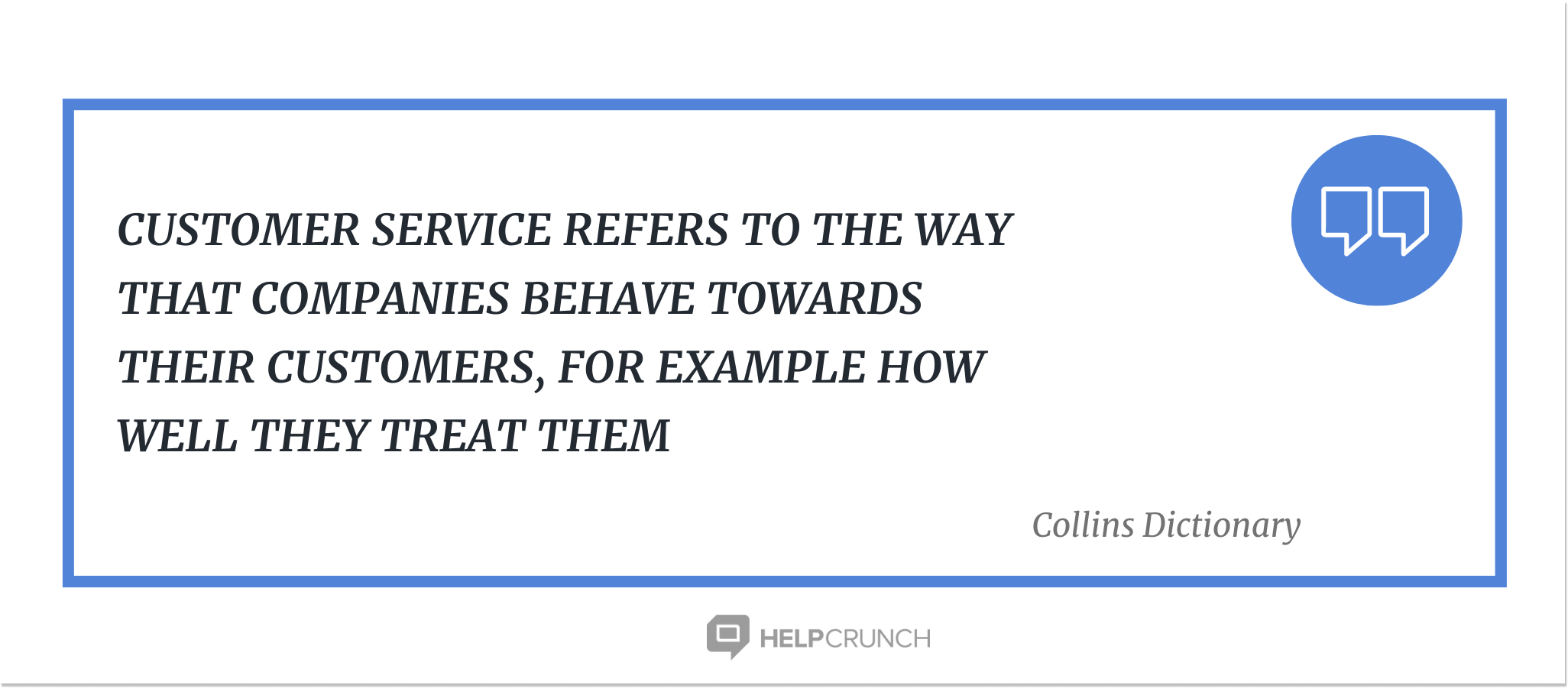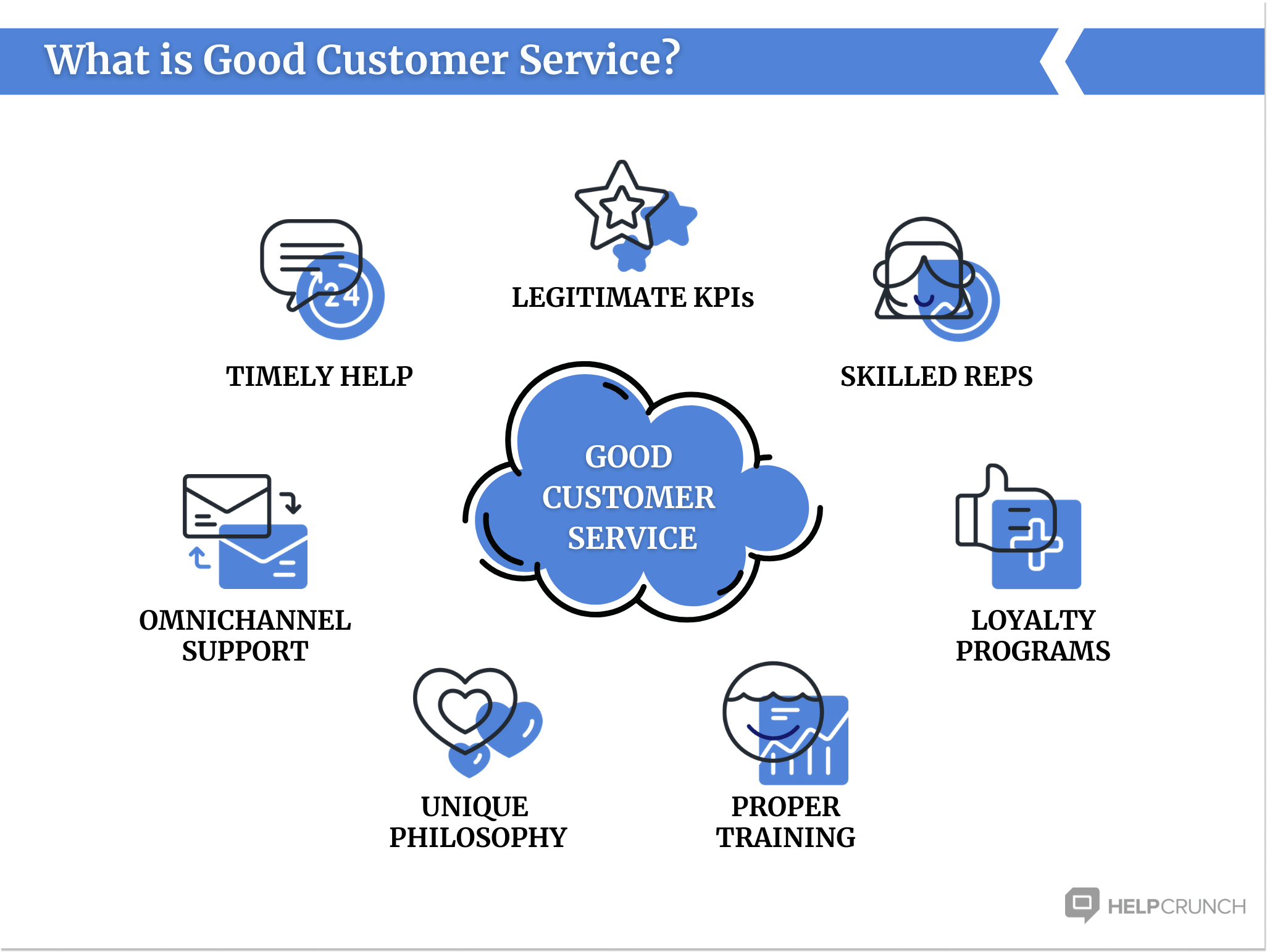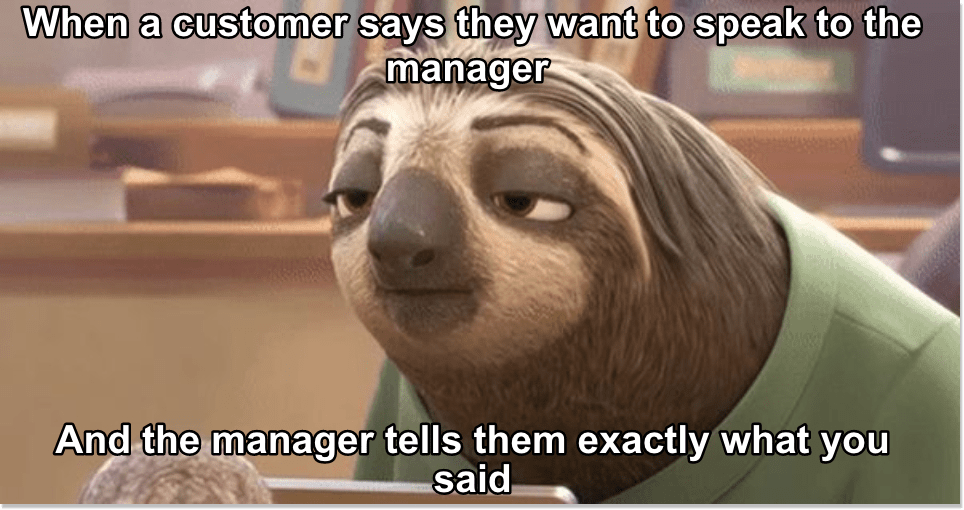The One-Stop Guide to Customer Service
Our ultimate guide to customer service is what you need to deepen your knowledge. Read on and take your customer care to the next higher level!
Written by Olesia Melnichenko

The basic knowledge in customer service might not be enough if a business wants to make its way in the industry. It’s great that you know how to speak to people politely, but there’s actually more to it.
In this ultimate guide, we’ve covered customer service from A to Z. Everything you need to know about its building blocks, the steps to take to create a winning support squad, and how to go the extra mile with it is elaborated on here. Let’s cut the talk and walk the walk!
What is customer service?

As you can see, the customer service definition refers to meeting the needs of clients. Customer care is the way a support rep helps people solve their issues, shows them how to use a product or service, and builds long-term customer relations afterward.
Once a client reaches out to a company, they make a request or note a complaint, and wait for quick and professional assistance. In customer service, everything comes down to the impeccable agents’ expertise.
Customer support in relation to customer service
You might think of customer service vs customer support pair in this context. On the one hand, these two concepts are like-for-like. But the truth is that the first one is directly connected to human interactions and lending a helping hand to people. The latter is all about software and its set-up issues. Why is customer care essential for a business? Let’s crack that down.
The importance of customer service
As the stats demonstrate, 70% of clients say they are eager to spend more money on a brand with positive customer service. However, 91% of customers leave without warning if their needs aren’t catered to. It’s you who decides which side to take with your customer care.
If ‘why is customer service important?’ is still an unanswered question to you, I’m here to change the situation for the better. Yes, customer service is vital for increasing your company’s revenue. However, there are more sound reasons except for this one.

It’s also essential to emphasize the importance of customer service to your reps. Once you help them feel motivated and appreciated, they will transfer positive vibes to clients, which can be rewarding. Considering some bonuses or gift cards for the staff is also a great idea. This way, you induce them to keep up the good work and build an unrivaled company image.
Channels for customer service
In today’s fast-paced world, people can choose from a variety of communication methods depending on what’s the most convenient for them. There are different types of customers and there’s no need, experience, or expectation alike. But they do share one thing: they crave the fastest customer service ever. You have to decide on a communication channel that will hit the nail.
Speaking of the types of customer service, we’ve narrowed them down to the following 6:
- Live chat customer service: give live chat software a shot if you strive for timely assistance. With it, your customer won’t have to wait for a reply for hours on end. You can add a live chat widget to any website’s page where you think visitors might need extra help, like a pricing page.
- Phone customer service: though the research proves phone support is becoming less popular, many companies still take advantage of it. But it has its drawbacks. Customers call a hotline, get into a queue, listen to hold music, and only after that (if they get lucky) a phone customer service agent picks up the phone. This way, clients lack speedy answers.
- Email customer service: using emails in your customer support workflow can be handy. You can create and send canned responses, attach valuable product-related info, links to your website, etc. But remember to get back to a person within 24 hours of the first contact — you don’t want to make a customer wait.
- Social media customer service: customer care over social media is your chance to be not only fast but also fun. Add a pinch of humor when communicating with clients on Facebook, Twitter, and Instagram. But not too much: disgruntled clients may not appreciate it.
- On-site customer service: this type of customer care is executed at a client’s place. This is a perfect opportunity to show your specific knowledge face-to-face and improve brand quality.
- Customer self-service: let those independent users find the right answers on their own by building a self-service knowledge base. Make it intuitive, modern, searchable, and trustworthy. Include such materials as how-to guides, videos, in-depth articles, etc. This help center is available 24/7, so your customers can search for whatever they want at any time.
What customer service channels do people enjoy the most? Here is a vivid research based on a variety of customer satisfaction metrics. Remember though that you can always go omnichannel.

Proactive vs reactive customer service
Just as the types of customer service, there are also different approaches. While other companies may wait for the sun to shine and a client who comes in with a question (which is a reactive attitude), you can perform proactive customer service.
Proactive customer service can really change your bottom line. Don’t take my word for it and look at the numbers: 70% of customers say they have a more favorable view of a brand that takes the initiative in their interactions. Besides, such an approach can increase customer loyalty by up to 5%.
What’s the difference between these two approaches mentioned above? Well, it’s pretty wide. The first concept (when you sit straight) is called reactive customer service. It means you are the second one who makes the step towards solving the client’s problems. Sure, there’s nothing wrong in holding such a position, but will you reap the benefits?
If you’re reactive in customer assistance, clients may feel alienated, which often brings in customer churn. Besides, dissatisfied people can spread negative word-of-mouth and juggle with a brand’s image.
The majority of forward-thinking companies, like HelpCrunch, give priority to proactive customer care and use numerous strategies to succeed:
- Utilizing a proactive chat feature
- Building a well-thought-out knowledge base
- Setting up in-app notifications
- Collecting customer feedback
- Offering loyalty programs

What is good customer service?
You may produce a fantastic product but people focus on excellent customer care, too. It’s important to deliver good customer service in order to wow your clients and make their wishes a reality. What do I mean by that? Read on.

Great customer assistance encompasses the efforts you invest to meet customers’ expectations, value their time, money, and provide valuable resources. Sure, it depends on the company’s goals and objectives. However, if you REALLY strive for delivering good customer support, you have no choice but to be proactive, choose personalization as your main priority, and reply to people in a timely manner. Trust me, the overall result will be directly connected to customer satisfaction and retention.
What happens if your customer support is not good enough? You’ll be impressed by customer horror stories we’ve discussed recently. Check them out: maybe you have to rethink your ‘system‘?
Creating a stellar customer support team
Before building a customer support team of your dreams, answer the following question: What does customer service mean to you? Someone will say, it’s simply being there for clients, others will say it’s all about creating an impeccable first impression.
For instance, we at HelpCrunch believe that perfect customer service is going the extra mile for our users and making sure their requests are taken care of.
Once you come up with an answer to the question above, share the inspiring thoughts with your team. They should sense your big takeaway to make customers happy day by day.
After that, having a solid plan won’t go amiss. Every little detail should be covered: what KPIs in customer service to monitor, what people to hire, and how to integrate support into your company. Speaking of the staff to employ, what qualifications should they obtain? This is our next stop.
What are the core customer service skills?
Recently, we’ve discussed the main 15 hard- and soft customer service skills a seasoned expert should have. The full picture looks like this:
| Clear communication and persuasiveness |
| To send the right message to a customer, clear communication and persuasiveness should be the first thing to check. Who wants to speak to a mumbling service agent? |
| Proactivity |
| Proactivity is your best friend if you want to show your commitment to people. Initiate the conversations, save the customer’s time by giving them the right solution at once, and the trick is done. |
| Patience and coolness |
| Breathe in, breathe out. Develop these skills not to lash out at a client having a rough day. |
| Empathy and emotional intelligence |
| Express your empathy and emotional intelligence every time things go sour. Include such lines as ‘I am really sorry..‘ and ‘I do everything possible to handle it‘. |
| Stress management |
| Make it one of your main positive (yes, you read it right) skills as a customer service job isn’t a piece of cake. |
| Flexibility |
| If you’re a live chat agent, you might need some flexibility to cope with several chats simultaneously. |
| Desire to improve |
| Make sure you have the desire to improve and you’ll become a star among customer care experts. |
| Perfect writing |
| Develop this skill to rock it every time you interact with a client. |
| Proficiency in languages |
| Proficiency in languages may come in handy for being on the same page with foreign customers if you work in a multilingual company. |
| Computer skills |
| Polish computer skills (at least the basics) to move up with the times and meet customers’ expectations better (you even don’t have to be a customer service software geek). |
| Product knowledge |
| Acquire product knowledge (in our case, it’s to be well-versed in customer support software) to fine-tune your workflow and maybe help the new hires. |
| Time management |
| Optimizing your time is needed to plan your day, without forgetting important tasks. |
Ways for fine-tuning your customer service team
A business should not only develop its marketing and sales strategies but also upgrade a customer care team. There are three paths you can follow to do that to your best advantage:
Implement customer service training activities
Knowledge is power. So, consider customer service training if you want your support squad to perform properly. Encourage your staff to attend various workshops (both online and offline), discuss tricky customer cases, and read specialized literature. Speaking of the customer service books, here is the list of the most peculiar ones:
- The Thank You Economy by Gary Vaynerchuk
- Be Our Guest: Revised and Updated Edition: Perfecting the Art of Customer Service by The Disney Institute and Theodore Kinni
- Getting Service Right: Overcoming the Hidden Obstacles to Outstanding Customer Service by Jeff Toister
- The Cult of the Customer: Create an Amazing Customer Experience that Turns Satisfied Customers into Customer Evangelists by Shep Hyken
- The Customer Rules: The 39 essential rules for delivering sensational service by Lee Cockerell
It’s OK if you’re not a bookworm. For those who are more into visual stuff, there are engaging TED Talks on customer service you can take advantage of. Here are a few you can be inspired by:
Salena Scardina: A Defining Time for Human Connection in Customer Service
Salena explains how not to lose the human link in customer service and tie that together with technology.
Tamekia MizLadi Smith: How to train employees to have difficult conversations
Is it worth investing in your customer support team? This video reveals that.
Frances Frei: How to build (and rebuild) trust
Trust is everything for customer care. Professor Frances Frei talks about how to develop it.
Develop a customer service mindset
Probably, you are wondering what is a customer service mindset? Customer service reps should solve clients’ issues. They’re also supposed to create a delightful experience that results in long-term rapport and loyalty. Such an approach is called a customer service mindset.
Once you possess such a customer-first attitude, you’ll notice how easy it is to create an added value for your clients. No matter if it’s finding a unique solution, suggesting an extra service, or just delivering a friendly service. We at HelpCrunch have already adopted that customer service philosophy meaning that we’re always ready to solve for as many clients’ needs as possible.
For instance, if we get a feature request, we process it ASAP and inform a customer when it’s finished. Besides, we work as a strong unit and can exchange the tasks easily: our marketing team is OK with helping clients handle their problems in chats.
If you want your users to feel appreciated and satisfied after any interaction, customer service orientation is what you have to master. No detail is too small here: how fast you reply, what language you use, what solutions you provide, and how they meet customers’ needs.
Improve customer service communication
No matter the channel you use for interacting with clients, constantly improving a customer communication strategy should be your top of mind priority. First of all, take care of the technical aspect. If you’re a first-time entrepreneur or have a startup, investing in the right customer service for small business will help you stay productive and proactive at all touchpoints.
Customer service is initially connected to how we speak to people. So, the next step is to learn it. Is it OK to use jargon when talking to a customer? Can you include lots of technical terms in your conversations? Is heavy humor actually allowed? You’ll find the answers in our recent blog post on chat etiquette (spoiler alert: all of the things mentioned are NOT OK 🙂
Are you in a customer care team and still don’t know how to deal with angry customers? No worries! It’s as easy as ABC. A quick workshop:
- Put yourself in the customers’ shoes
- Be empathetic
- Stay proactive
- Listen to what your clients are saying
- Keep calm
Now you’re good to go to try these pieces of advice in practice! 🙂
Bonus
Phew! Today’s all about serious theoretical stuff, isn’t it? To buck up a little, here are some hilarious customer service memes for you to look through. Check them out, laugh, and remember: customer support is a pleasant thing to do!

Final Thoughts
Now that you’re aware of all the ins and outs of customer service, it’s time to connect all the dots. Remember that you do your job for the benefit of clients, and they will appreciate your efforts. Build a stellar support team, share valuable insights with them, and teach them to create an unforgettable customer experience.
You can take your customer service up a notch by going for a powerful toolset. Sign up for HelpCrunch: maybe its features are exactly what you are looking for?





